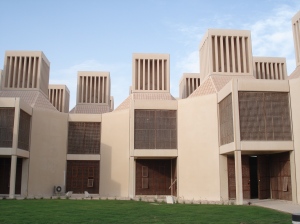How We Look at Architecture? Aldhaher “the Visible” Wa (and) Albatinthe (the Invisible) in Architecture
Architecture is the reflection of the cultural, social, political and economic conditions of civilizations. How architecture is viewed depends of the people and society who interact with it. While modern man depends on architecture in all his daily activities for living, work, entertainment, education and health, yet architecture is taken for granted as part of our existence and is not receiving enough attention nor contemplation. But if we consider architecture an intrinsic part of our existence, then we ought to view it as a mirror that reflects not only how others see us but also how we see and value our inner self. Architecture is the extension of our existence and constitutes a significant part of our daily experience.
العمارة تعكس الاوضاع الثقافية والاجتماعية والسياسية والاقتصادية التى تمر بها الحضارات. وتعتمد النظرة للعمارة على الانسان والمجتمع الذى ينظر اليها ويتعامل معها. وبالرغم من ان الانسان الحديث يعتمد على العمارة فى جميع نواحى حياته المعيشية والعملية والترفيهية والتعليمية والصحية الا ان العمارة تعتبر جزء من الواقع ولا تأخذ حقها من التأمل والتفكير. ولكن اذا اعتبرنا العمارة احد المكونات الاساسية لحياتنا فيجب ان ننظر اليها كما ننظر لانفسنا فى المرآة قبل الخروج من المنزل لانها تعكس ليس فقط كيف يرانا الاخرون ولكن كيف نرى انفسنا ونقدرها. العمارة هى امتداد لحياة الانسان ومكون اساسى لتجربته اليومية الحياتية
Architecture can be seen in two ways. First there is the “visible” (Aldhair), or how we “view” of architecture, either exterior or interior, that is acquired through its physical aspects. The images and forms of its appearances constitutes the images and mental pictures of architecture. Repetitions of these images construct a “style or character” that is attached to a certain era or place. Second there is the “invisible” (Albatin), or how we “experience” this architecture that constitute the meanings and knowledge that is acquired through our interaction with it.
نحن نرى العمارة بطريقتين، الاولى هى رؤية “الظاهر” للعمارة من الخارج او الداخل الذى توفره لنا الاشكال المعمارية والتى تصبح فيما بعد المكون الاساسى للصورة الذهنية للعمارة، ومع تكرار تلك الاشكال المعمارية تتكون لدينا صورة عن الطابع المعمارى لمكان ما او زمان ما. أما الرؤية الثانية “الباطن” فتتكون من التجربة الشخصية والتى تكون المعانى و المعارف عن العمارة
Our evaluation and appreciation of architecture depends on our role as well as our cultural and intellectual background. The evaluation and appreciation of architecture by critics and people is usually contradictory. While critics find the design of an architectural project creative and successful, people’s experience find it unsatisfactory and uncomfortable. This contradiction is the result of critics’ focus on the “visible” (Aldhahir); its design concept and creative solutions, while people’s evaluation is mainly derived from the “invisible” (Albatin) that is the result of their daily experience.
يختلف ايضا مدى تقديرنا وتقييمنا للعمارة باختلاف دورنا وخلفياتنا الثقافية والمعرفية. وتتضارب فى اغلب الاحيان اراء المتخصصين والنقاد مع اراء الناس والمتعاملين مع العمارة. فبينما يجد النقاد فى تصميم احد المشروعات العناصر المتكاملة للنجاح والابداع نجد ان تجربة الناس اليومية غير مرضية وغير مريحة. وينبع هذا التضاد من تركيز النقد المعمارى على “الظاهر” وكيفية تكوينه وعناصر الابداع فيه بينما يتفاعل الناس بدرجة اكبر مع “الباطن” والتجربة الانسانية المباشرة مع العمارة.
While it is “the” most popular place in Doha, Qatar that attracts residents and tourists, Souq Waqif was denied prestigious architectural awards due to its “unauthentic” traditional appearance.
بينما يعتبر سوق واقف اكثر الاماكن نجاحا وشعبية بالدوحة، قطر، فانه لم يحصل على جوائز معمارية نظرا لاعتباره تقليد “غير اصيل” لاشكال العمارة التراثية القطرية
Qatar university buildings, designed by architect Kamal Al-Kafrawy, received numerous architecture awards and was praised by critics as a creative design that expresses a modern interpretation of Islamic architecture. The building is “disliked” by its users due to its confusing way finding, waste areas, lack of interior privacy and monotony. While it succeeded in creating a “style and character” that became part of QU image, it failed to satisfy the users nor provide them with a meaningful experience.
يعتبر النقاد مبانى جامعة قطر التى صممها المعمارى كمال الكفراوى واحدة من انجح نماذج العمارة التى تعكس اتجاه متميز لعمارة اسلامية حديثة، فان المبنى يعتبر من وجهة نظر مستعمليه لا يوفر حركة داخلية مريحة ويحتوى على مساحات داخلية غير مستعملة ولا يوفر خصوصية لمستخدميه. فبينما نجح المبنى فى ايجاد طابع معمارى مرتبطا بجامعة قطر الا انه لم يحقق التجربة الانسانية الايجابية لمستعمليه
Then, how can we judge architecture? What constitutes it successes and failures? Is it the “critics’” views of the “people’s” daily experiences?
كيف اذا يمكننا الحكم على العمارة؟ ما هى مقومات نجاحها او فشلها؟ هل هى “رؤية” النقاد ام “تجربة” الناس؟


هي تجربة الناس بلا شك، لأن العمارة -من وجهة نظري المتواضعة- هي الرسالة التي خرجت من روح هذا المعماري عبر خطوط شكَّلَتْ تلك الارتفاعات والمساحات، حيث رسمتها خبرته باستخدام يده وأرسل من خلالها، شاء أم لم يشأ، رسالته التي تحوي طاقته سلبية كانت أم إيجابية. وتعبر في الوقت ذاته عن مدى نضجه المعرفي، فتستقبلها "فطرة" الناس إما بالقبول أو بالرفض. ومدى عمق المعماري في معرفة أسرار الأشكال المعمارية وتأثيراتها المختلفة ومايتجاذب منها ومايتنافر هو باعتقادي ما سيُشكِّل العامل الأول لنجاح تجربته المعمارية.
ReplyDelete